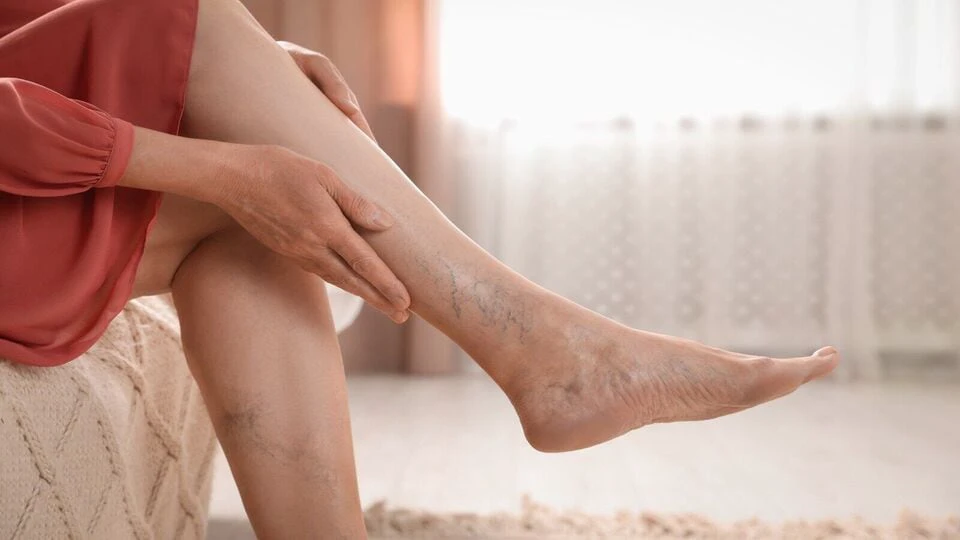Varicose veins are enlarged veins that typically appear dark blue or purple just beneath the skin’s surface. Although they commonly develop in the legs, they can also occur in other areas of the body due to damaged valves within the veins.
These damaged valves allow blood to flow backwards and pool, resulting in their characteristic distortion, as per the National Heart, Lung, and Blood Institute. This condition can impact quality of life by causing pain and discomfort. Understanding how to manage varicose veins effectively is vital for maintaining both physical health and self-confidence.
What causes varicose veins?
Several factors increase the likelihood of developing varicose veins, according to Dr Anoop T, Consultant in Vascular & Endovascular Surgery at Aster Whitefield Hospital.
- Genetics: A family history of varicose veins significantly heightens your risk.
- Hormonal changes: Women are particularly vulnerable during pregnancy, menopause, or when using hormonal birth control due to fluctuating hormone levels.
- Age: As we age, our veins lose elasticity, making varicose veins more likely to develop.
- Lifestyle factors, such as prolonged sitting or standing and excess weight, can increase pressure on the veins.
Who is most at risk of varicose veins?
Specific demographics are more prone to varicose veins:
- Women: Hormones affect their likelihood of developing this condition.
- Older adults: With age, the risk escalates due to decreased vein elasticity.
- Sedentary workers: Jobs that require extended periods of sitting or standing can exacerbate the issue.
- Pregnant women: The increased blood volume and hormonal shifts that occur during pregnancy elevate their risk.
Symptoms of varicose veins
While some may not show symptoms, common indicators of varicose veins include:
- Visible bulging veins
- Heavy or achy legs
- Swelling in the legs or ankles
- Skin changes, including discolouration or ulceration in severe cases
If you notice such symptoms, consulting a healthcare professional is wise.
Side effects of varicose veins
If left unmanaged, varicose veins can lead to serious complications, such as:
- Venous eczema: Skin inflammation and irritation can occur.
- Ulcers: Open sores might develop due to poor blood flow.
- Deep vein thrombosis (DVT): Blood clots can form in deeper veins, posing a risk of life-threatening situations, such as pulmonary embolism.
Treatment options for varicose veins
For managing varicose veins, various treatment methods are available, depending on severity:
- Compression stockings: They apply gentle pressure, enhancing circulation and reducing discomfort.
- Sclerotherapy: An injected solution is used to collapse the affected veins, causing them to fade over time.
- Laser treatments: Techniques like pulsed laser therapy close smaller veins without incisions
- Endovenous laser therapy (EVLT) or radiofrequency ablation (RFA): These methods effectively treat larger veins by sealing them with heat.
Lifestyle modifications to manage varicose veins
Beyond medical treatments, consider making specific lifestyle changes to help manage varicose veins:
- Stay active: Regular activities like walking or swimming can boost circulation.
- Maintain a healthy weight: Losing excess weight reduces pressure on veins.
- Change positions frequently: Taking breaks to walk or stretch during prolonged periods of sitting or standing is beneficial.
The role of nutrition in varicose veins
A nutritious diet also supports vein health. Here are some tips to consider:
- Stay hydrated: Maintaining good hydration is crucial for maintaining healthy circulation.
- Eat balanced meals: Focusing on fruits, vegetables, and whole grains promotes vascular well-being.
- Limit salt intake: Excess salt can contribute to swelling and fluid retention.
Importance of regular check-ups for varicose veins
If you have varicose veins or are at risk, schedule regular check-ups to monitor your condition and ensure its progression. These visits enable healthcare providers to monitor your condition, recommend necessary lifestyle adjustments, and assess whether further treatment is required, as per The Permanente Journal. Early detection is key to preventing complications.
When to seek help for varicose veins
Be aware of troubling symptoms such as sudden swelling, changes in skin appearance, or worsening leg pain. If these arise, it’s essential to seek medical attention promptly. A vascular surgeon can perform a comprehensive evaluation and recommend a treatment plan tailored to your specific situation.
While varicose veins often presents as a cosmetic issue, they can lead to significant health complications if ignored. By understanding the causes, symptoms, and risk factors associated with varicose veins and adopting recommended lifestyle changes and treatments, you can proactively manage your vein health.
